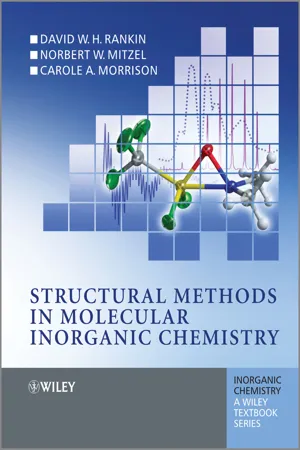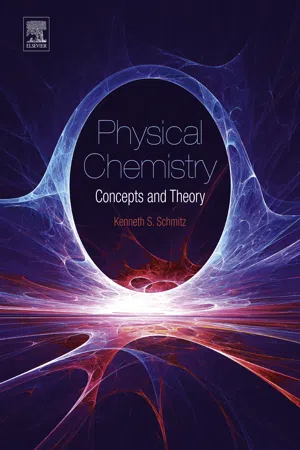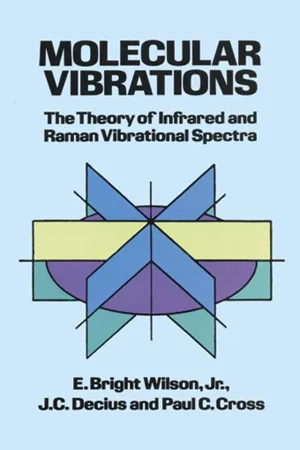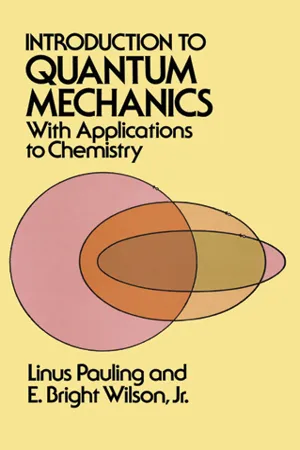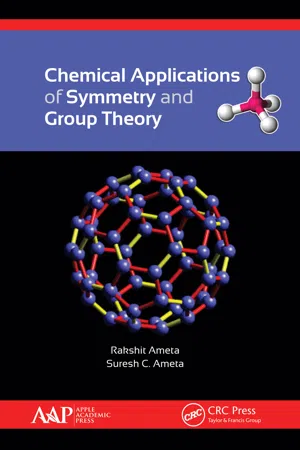Chemistry
Molecular Vibration
Molecular vibration refers to the periodic motion of atoms within a molecule as they alternately move toward and away from each other. This motion occurs due to the stretching and bending of chemical bonds, and it gives rise to characteristic vibrational frequencies that can be studied using techniques such as infrared spectroscopy. Understanding molecular vibrations is crucial for analyzing the structure and behavior of molecules.
Written by Perlego with AI-assistance
Related key terms
Related key terms
1 of 4
Related key terms
1 of 3
7 Key excerpts on "Molecular Vibration"
- eBook - ePub
Modern Vibrational Spectroscopy and Micro-Spectroscopy
Theory, Instrumentation and Biomedical Applications
- Max Diem(Author)
- 2015(Publication Date)
- Wiley(Publisher)
Chapter 1 Molecular Vibrational MotionThe atoms in matter – be it in gaseous, liquid, or condensed phases – are in constant motion. The amplitude of this motion increases with increasing temperature; however, even at absolute zero temperature, it never approaches zero or perfect stillness. Furthermore, the amplitude of the atomic motion is a measure of the thermodynamic heat content as measured by the product of the specific heat times the absolute temperature. If one could observe the motion in real time – which is not possible because the motions occur at a timescale of about 1013 Hz – one would find that it is completely random and that the atoms are most likely to be found in ellipsoidal regions in space, such as the ones depicted in X-ray crystallographic structures. Yet, the random motion can be decomposed into distinct “normal modes of vibration.” These normal modes can be derived from classical physical principles (see Section 1.2 ) and are defined as follows: in a normal mode, all atoms vibrate, or oscillate, at the same frequency and phase, but with different amplitudes, to produce motions that are referred as symmetric and antisymmetric stretching, deformation, twisting modes, and so on. In general, a molecule with N atoms will have 3N − 6 normal modes of vibrational normal modes.At this point, a discrepancy arises between the classical (Newtonian) description of the motion of atoms in a molecule and the quantum mechanical description. While in the classical description the amplitude of the motion, and thereby the kinetic energy of the moving atoms, can increase in arbitrarily small increments, the quantum mechanical description predicts that the increase in energy is quantized, and that infrared (IR) photons can be absorbed by a vibrating molecular system to increase the energy along one of the normal modes of vibration. - D. W. H. Rankin, Norbert Mitzel, Carole Morrison(Authors)
- 2013(Publication Date)
- Wiley(Publisher)
Figure 2.14 , alongside those for the harmonic potential. For the anharmonic oscillator, it is clear that the vibrational energy levels associated with a particular vibration have diminishing separation with increasing quantum number, but there is a finite number of them below the bond dissociation limit. In contrast, the harmonic model has equally spaced vibrational levels that in principle go on for ever. Around the equilibrium structure, however, the two functions are broadly similar. This is the validation for the harmonic approximation, which is routinely used in the calculation of vibrational frequencies by quantum mechanical methods (Section 3.3).8.3 Observing Molecular Vibrations
As chemical bonds involve electrostatic attraction between positively charged atomic nuclei and negatively charged electrons, the displacements of atoms during a Molecular Vibration lead to distortions in the electric charge distribution of the molecule, which can be resolved into dipole, quadrupole, etc. terms in various directions. Molecular Vibrations therefore lead to oscillations of electric charge, with frequencies governed by the normal vibration frequencies of the system.Oscillating molecular dipoles are observed by infrared spectroscopy. Raman spectroscopy, which depends on the polarization of the electron cloud induced by an incident light beam, reveals the changes in energy due to vibrational excitations when light is scattered. These are by far the most important ways of studying vibrations, and are described in detail in the following sections, but vibrational frequencies may also be determined by analysis of high-resolution electronic spectra (Section 9.4.2; see also the on-line supplement to chapter 8), and by inelastic scattering of neutrons and electrons (Section 8.3.4).8.3.1 Absorption in the Infrared
An oscillating molecular dipole can interact directly with the oscillating electric vector of electromagnetic radiation of the same frequency, leading to resonant absorption of radiation. The quantum energy of the radiation (hv ) is equal to the quantum energy of the oscillator (hω ) if ν ≡ ω, so resonant absorption introduces exactly enough energy to raise the oscillator from a level v to the level (v + 1) (Figure 8.2(a) ). Molecular Vibrations, which have frequencies that are generally between 1011 and 1013 Hz, corresponding to 30–3000 cm−1- eBook - ePub
Physical Chemistry
Concepts and Theory
- Kenneth S Schmitz(Author)
- 2016(Publication Date)
- Elsevier(Publisher)
A constraint on the motions of the nuclei during the vibration is that the center of mass is stationary. If this were not true then vibrational motions would cause the molecule to move as in translation. This requires cooperation among the atoms in the molecule. But cooperation among the atoms in a molecule is not unlike cooperation among humans in a group. If the group is small enough then everyone in the group is aware of the activities of others within the group, and all parties involved move in unison to carry a specific task. In a similar way, the nuclei in small molecules move in a specific way to maintain a fixed center of mass. These are the normal modes of the molecules, where every atom moves with the same frequency. However, when a group of humans becomes very large, such as in corporations, the activities become compartmentalized. An example is the “bundling” of services, such as a telephone provider where the land phone and the cell phone billings may be separate. For large molecules the vibrations are also “localized” to specific groups. An example is the frequency of vibration of the CH 3 group in aromatic compounds. Let us step back and visualize how the incoming electric field, viz, electromagnetic radiation or light, might interact with the vibration modes of the molecule. The distribution of atoms within the molecule and the strength of the chemical bonds determine the strength of the vibrational modes of the array of nuclei and how easily the electron cloud can be distorted. There are two mechanisms by which light can interact with the molecule. The first mechanism is that the light can be absorbed by the molecule as it undergoes vibration. The dipole moment μ m is a measure of the strength of this interaction. The second mechanism is that light can be scattered by the molecule. Light scattering is associated with the polarizability of the electron cloud of the molecule denoted by the parameter α - eBook - ePub
Molecular Vibrations
The Theory of Infrared and Raman Vibrational Spectra
- E. Bright Wilson, J. C. Decius, Paul C. Cross(Authors)
- 2012(Publication Date)
- Dover Publications(Publisher)
CHAPTER 2THE VIBRATION OF MOLECULES
The study of Molecular Vibrations will be introduced by a consideration of the elementary dynamical principles applying to the treatment of small vibrations. In order that attention may be focused on the dynamical principles rather than on the technique of their application, this chapter will employ only relatively familiar and straightforward mathematical methods, and the illustrations will be simple. This will serve adequately as an introduction to the applications of quantum mechanics and group theory to the problem of Molecular Vibrations. Since, however, these straightforward methods become cumbersome and impractical, even for simple molecules, equivalent but more powerful techniques using matrix and vector notations will be discussed in Chap. 4 .2-1. Separation of Rotation and Vibration1
The logical way to begin the mathematical treatment of the vibration and rotation of a molecule is to set up the classical expressions for the kinetic and potential energies of the molecule in terms of the coordinates of the atoms, and then to use these expressions to obtain the wave equation for vibration, rotation, and translation. Following this, it should be proved that when the proper coordinate system is used, the complete wave equation can be approximately separated into three equations, one for translation, one for rotation, and one for vibration. Unfortunately, this procedure is not a very simple one and utilizes more quantum-mechanical technique than is required for the discussion of the vibrational equation itself. Consequently, the actual carrying out of the separation will be deferred until Chap. 11 , and only a summary of the results thus obtained will be presented at this point. The reader who prefers to follow the more logical order may turn to Chap. 11 - Linus Pauling, E. Bright Wilson, E. Bright Wilson(Authors)
- 2012(Publication Date)
- Dover Publications(Publisher)
CHAPTER X THE ROTATION AND VIBRATION OF MOLECULESThe solution of the wave equation for any but the simplest molecules (some of which are discussed in Chap. XII ) is a very difficult problem. However, the empirical results of molecular spectroscopy show that in many cases the energy values bear a simple relation to one another, such that the energy of the molecule (aside from translational energy) can be conveniently considered to be made up of several parts, called the electronic, energy , the vibrational energy , and the rotational energy . This is indicated in Figure 34–1 , showing some of the energy levels for a molecule of carbon monoxide, as calculated from the observed spectral lines by the Bohr frequency rule (Sec. 5a ). It is seen that the energy levels fall into widely separated groups, which are said to correspond to different electronic states of the molecule. For a given electronic state the levels are again divided into groups, which follow one another at nearly equal intervals. These are said to correspond to successive states of vibration of the nuclei. Superimposed on this is the fine structure due to the different states of rotation of the molecule, the successive rotational energy levels being separated by larger and larger intervals with increasing rotational energy. This simplicity of structure of the energy levels suggests that it should be possible to devise a method of approximate solution of the wave equation involving its separation into three equations, one dealing with the motion of the electrons, one with the vibrational motion of the nuclei, and one with the rotational motion of the nuclei. A method of this character has been developed and is discussed in the following section. The remaining sections of this chapter are devoted to the detailed treatment of the vibrational and rotational motion of molecules of various types.34. THE SEPARATION OF ELECTRONIC AND NUCLEAR MOTION- Rakshit Ameta, Suresh C. Ameta(Authors)
- 2016(Publication Date)
- Apple Academic Press(Publisher)
CHAPTER 8Molecular VibrationS
CONTENTS
8.1 Normal Modes of Vibration 8.1.1 Translational Motion 8.1.2 Rotational Motion 8.1.3 Vibrational Motion 8.2 Molecular Vibrations 8.2.1 Bond Stretching Vibrations8.2.1.1 Symmetric Stretching Vibration (νs )8.2.1.2 Asymmetric Stretching Vibration (νas )8.2.2 Bending Vibrations 8.2.2.1 In-Plane Mode 8.2.2.2 Out-of-Plane Mode 8.3 Selection Rules for IR and Raman Spectra 8.4 The Mutual Exclusion Rule 8.5 Normal Mode Analysis 8.5.1 General Sequence of Steps for Normal Mode Analysis8.6 AB2 Molecules (C2v Point Group)8.6.1 Cartesian Coordinate Method 8.6.2 Internal Coordinate Method8.7 AB3 Pyramidal Molecules (C3v Group)8.7.1 Cartesian Coordinate Method 8.7.2 Internal Coordinate Method8.8 AB4 Molecules (Td Point Group)8.8.1 Cartesian Coordinate Method 8.8.2 Internal Coordinate Method8.9 AB6 Molecules (Oh Point Group)8.9.1 Cartesian Coordinate Method 8.9.2 Internal Coordinate Method8.10 A2 B2 Molecules (C2h Group)8.10.1 Cartesian Coordinate Method 8.10.2 Internal Coordinate Method 8.11 Overtones and Binary/Ternary Combination Bands 8.11.1 Overtone Bands 8.11.2 Combination Bands 8.11.3 Difference Bands 8.12 Fermi Resonance 8.13 Solid State Effects 8.14 Site Symmetry Approximation Keywords8.1 NORMAL MODES OF VIBRATION
The complex vibrations of a molecule are the superposition of relatively simple vibrations, which are called the normal mode of vibration. Suppose a molecule has N number of atoms, then total degrees of freedom for that molecule is 3 N. The normal mode corresponds to coordinates at X-, Y- and Z-axes.Each normal mode of vibration has a fixed frequency. Molecules have translational, rotational and vibrational motions, and therefore, total degrees of freedom (3 N) can be determined for each motion depending on type of motion.8.1.1 TRANSLATIONAL MOTION
In this motion, molecule moves from one place to other but without changing its shape. It means that molecule moves as a whole unit. Translational motion uses all the three coordinates. Therefore, number of translational degrees of freedom is 3.- eBook - ePub
Molecules and Radiation
An Introduction to Modern Molecular Spectroscopy. Second Edition
- Jeffrey I. Steinfeld(Author)
- 2012(Publication Date)
- Dover Publications(Publisher)
4Rotation and Vibration of Diatomic Molecules
The complete description of any molecular state involves a number of different degrees of freedom, each with its associated coordinate. There is translation in three-dimensional space (with coordinates X , Y , Z ), rotation in space (with angular coordinates θ , φ , χ ), vibrational motion of the nuclei (with an internuclear separation coordinate for each pair of atoms, such as R in a diatomic molecule), and motion of the electrons (with internal coordinates r ). In addition, there may be electron spin and nuclear spin variables.The simplest starting point for considering the total energy spectrum of a molecule is to assume that all of these degrees of freedom are separable from one another. Classically, this means that the equations of motion separate into individual equations for each of the coordinates and the total energy is the sum of fixed individual contributions from each of the degrees of freedom; that is,(4.1)Quantum mechanically, this requires that the terms in the Hamiltonian operator corresponding to each variable commute with all the other terms, so that the wave function for the total system can be written as a product of wave functions for each variable,(4.2)As we shall see, some of the degrees of freedom (such as translation) are very well separated from all the others, whereas for others, the separability approximation is not a good one at all.1 Rigid Rotor Hamiltonian, Eigenfunctions, and Spectra
We have seen, in the last chapter, that a particular electronic state of a diatomic molecule in the Born-Oppenheimer approximation is characterized by a potential energy curve E (R ), with a minimum at some R e if the molecule is stable. Let us consider a diatomic molecule in one of its electronic states, and observe it in a set of coordinates moving with the constant velocity of the center of mass of the molecule, corresponding to its translational energy and momentum; these are called “space-fixed axes,” although they are really moving at a constant velocity. The molecule, however, may be rotating in this coordinate system, and the rotation is described by the angular coordinates θ (t ) and φ (t ); the third angle χ corresponds to rotation about the internuclear axis itself (see figure 4.1
Index pages curate the most relevant extracts from our library of academic textbooks. They’ve been created using an in-house natural language model (NLM), each adding context and meaning to key research topics.
Explore more topic indexes
Explore more topic indexes
1 of 6
Explore more topic indexes
1 of 4

